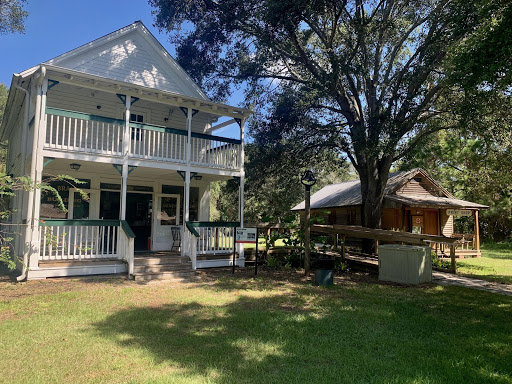
Story and photo Annabella Keim
Set during the turn of the century, this museum — hidden within the Boyd Hill Nature Preserve — is filled with all kinds of historical buildings: a sawmill; a blacksmith; a sunflower garden; the Brantley building; an old-fashioned gas station; a print shop; a sugar mill and the Endicott house, an authentic home that was built in 1898.
Michael Bowen, a passionate volunteer who’s worked at the settlement since 1989, shared his experiences while he gave a personal tour of the sawmill, Endicott house and gas station. He’s seen the park grow from just the Brantley building and the Endicott house to what it is today.
“Everybody knows, just come down here and ask for Mike,” Bowen said. He describes the park as a “hidden gem.”
Bowen and his late wife, Connie, dedicated their weekends to the settlement for decades. She loved the Endicott house and spent much of her time perfecting the summer kitchen with her decorations. When the settlement hosted shows, she would use the old wood-burning oven in the summer kitchen to make pancakes and bacon for the folks who came through.
“My wife really enjoyed telling these stories. She would do the research so she wasn’t just telling you a fairytale,” Bowen said.
Although his wife passed away in 2015, Bowen continues to volunteer his time in her memory. A photo of her cooking on the wood stove is on the informational sign just outside of the kitchen.
They both were responsible for helping design the gas station onsite. Modeled after an old Sinclair gas station, the city built the structure as a place for restrooms in the park. To Bowen, it stands out like a “white elephant” among the other buildings.
Inside the gas station is a replica Ford Model T, old fluid canisters, hubcaps to cars that no longer exist and a huge display board titled “Knucklebusters of the Past,” with at least 30 different vintage tools fastened to it. Most of the stuff in the garage came from Bowen’s personal collection.
“I could make 10 of those boards and still have more left,” he said. All of his “old junk” came in handy at the park.
The sawmill, built in 1925 and still running to this day, was Bowen’s favorite spot in the park. As long as someone is standing around to watch their demonstrations, they will continue to saw.
The entire settlement depends on volunteers, but there are often not enough people who know about it or are interested enough to help during events and shows.
There used to be people stationed at each of the buildings to give in-depth tours. However, the number of volunteers has declined over the years — and so have the number of shows, events and open buildings.
“It’s a shame. You get something like this, it’s really nice,” Bowen said. “I enjoy it or I wouldn’t be down here.”
Over at the Brantley building, there is a general store you can actually shop at, with trinkets, candy and toys from the time period. The cashier, Nancy Millard, spends her time running the store and sharing information about the park to guests. The sunflower garden is one of her favorite spots in the park.
Beside the Brantley building and the Endicott house, the other structures are replicas built in the 1980s and 1990s.
The Pinellas Pioneer Settlement is maintained by the nonprofit Pioneer Settlement and the St. Petersburg Parks and Recreation department.
Interested in volunteering? Visit the Facebook page, “Pinellas Pioneer Settlement,” give them a call at (727) 893-7326 or take a trip out to the Boyd Hill Nature Preserve.


